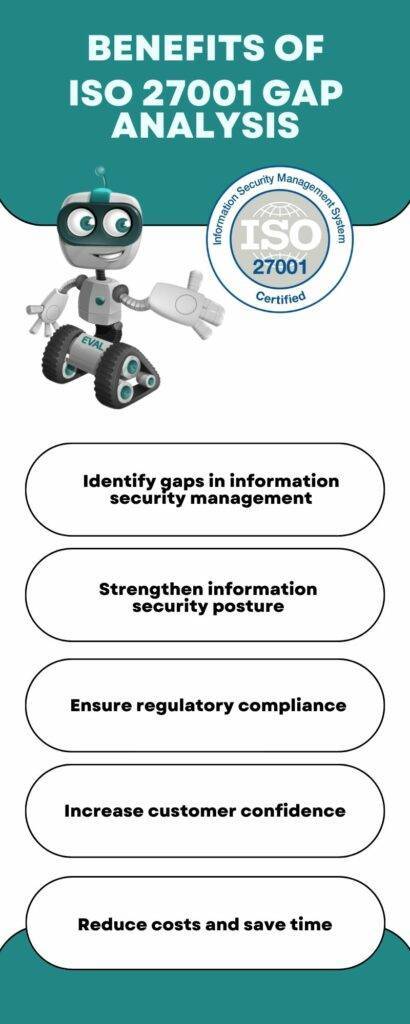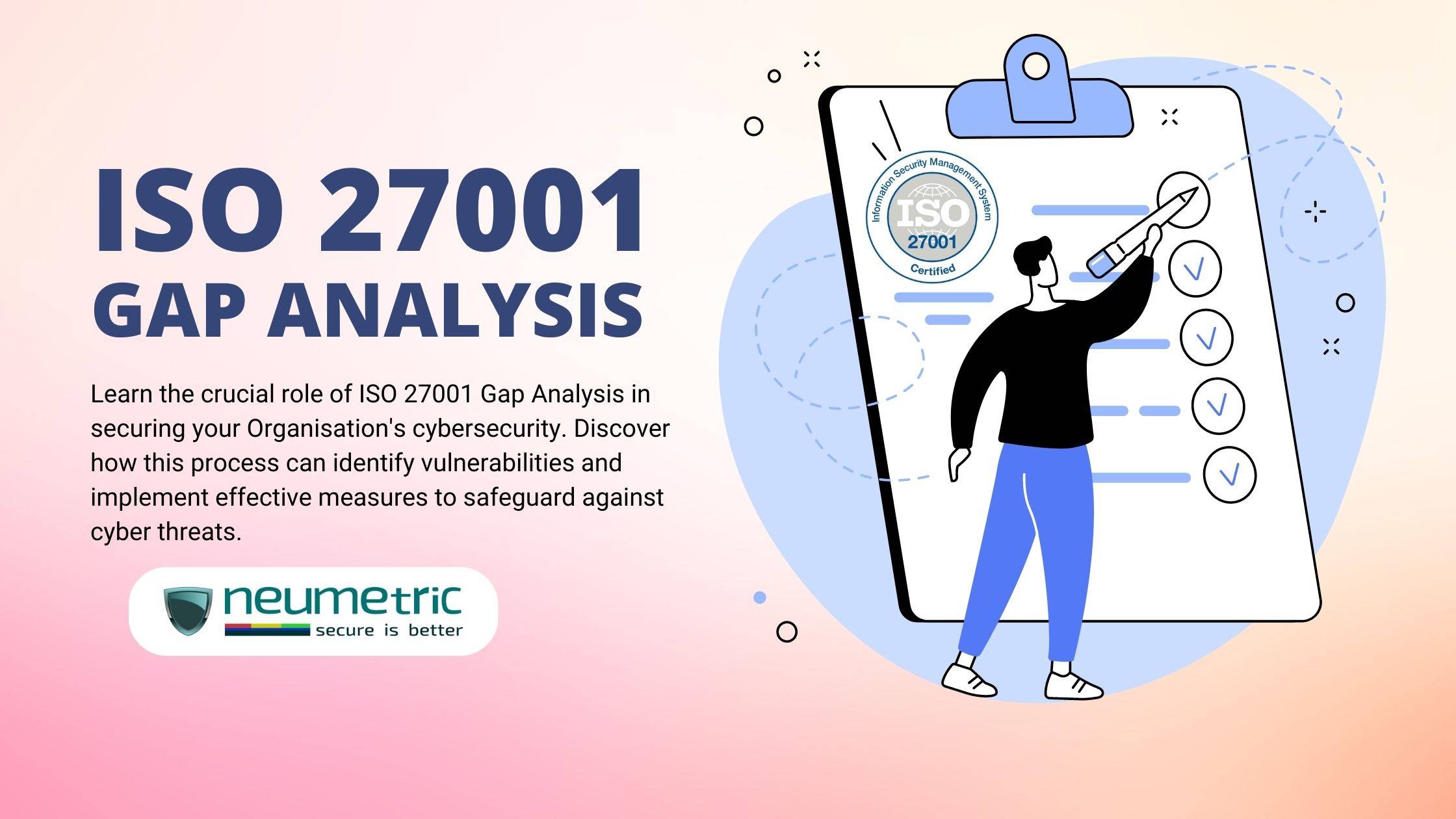Table of Contents
ToggleIntroduction
ISO 27001 is a widely accepted international Standard for Information Security Management Systems [ISMS]. It provides a framework for Organisations to manage & protect their sensitive information through a systematic approach. ISO 27001 Gap Analysis is a process that helps Organisations identify the gaps between their Current State of Information Security Management & the requirements of the ISO 27001 Standard.
In today’s digital age, cybersecurity is crucial for Organisations to protect their sensitive information, maintain customer trust, & comply with legal & regulatory requirements. Cyber attacks can cause significant financial & reputational damage, making it essential for Organisations to prioritise their cybersecurity efforts.
The purpose of ISO 27001 Gap Analysis is to assess an Organisation’s current Information Security Management System against the requirements of the ISO 27001 Standard. It helps Organisations identify areas of improvement to enhance their cybersecurity posture, reduce the risk of cyber incidents, & comply with legal & regulatory requirements.
Understanding ISO 27001 Gap Analysis
Gap analysis is a process that helps Organisations identify the difference between their Current State & their Desired State. In the context of ISO 27001, Gap Analysis involves assessing an Organisation’s current Information Security Management System against the requirements of the ISO 27001 Standard to identify Gaps & areas for improvement.
The Current State refers to an Organisation’s existing Information Security Management System, while the Desired State refers to the requirements of the ISO 27001 Standard. The Gap Analysis process identifies the Gaps between the Current State & Desired State, enabling Organisations to improve their Information Security Management System.
The Process of Conducting ISO 27001 Gap Analysis
ISO 27001 Gap Analysis is a process that helps Organisations evaluate the effectiveness of their Information Security Management Systems [ISMS] by identifying Gaps between their Current State & the Desired State of Compliance with the ISO 27001 Standard. The ISO 27001 Gap Analysis process involves five key steps, each of which is critical to the overall success of the effort. In this article, we will take a closer look at each of these steps.
- Identifying Scope & Objectives: The first step in conducting an ISO 27001 Gap Analysis is to identify the Scope & Objectives of the Assessment. This involves determining which Information Assets need to be protected, which Organisational Units need to be assessed, & what the objectives of the Assessment are. The Scope should be defined clearly, & it should cover all the aspects of the ISMS that need to be assessed. This step ensures that the assessment is tailored to the unique needs of the Organisation & its specific objectives.
- Assessment of current controls: The next step is to assess the Organisation’s current ISMS, including its Policies, Procedures, & Controls. This involves reviewing documentation, interviewing stakeholders, & conducting site visits. This step helps identify existing security Controls & highlights areas where they may be inadequate or where they need to be enhanced. The assessment should cover all the relevant aspects of the ISMS & should be conducted by experienced professionals. This step is essential to ensure that the assessment is thorough & that all aspects of the ISMS are reviewed.
- Identification of gaps & risks: Based on the Assessment of the current ISMS, the next step is to identify Gaps between the Current State & the Desired State, including Risks & Vulnerabilities. This involves analysing the results of the Assessment & identifying areas for improvement. The Gaps & risks should be identified systematically, & they should be prioritised based on their severity & impact on the Organisation. This step helps ensure that the Organisation’s ISMS meets the requirements of the ISO 27001 Standard.
- Recommendations for improvement: The next step is to develop recommendations for improving the ISMS. This involves developing an action plan to address the identified gaps & risks, including assigning responsibility for implementation & developing a timeline. The recommendations should be practical & achievable, & they should be based on industry best practices & ISO 27001 requirements. This step helps ensure that the Organisation’s ISMS is effective, efficient, & in compliance with the ISO 27001 Standard.
- Prioritising & implementing solutions: The final step is to prioritise the recommendations & implement solutions to improve the ISMS. This involves assigning resources & monitoring progress to ensure that the solutions are effective. The solutions should be prioritised based on their impact & should be implemented systematically. The progress should be monitored regularly, & adjustments should be made as necessary. This step helps ensure that the Organisation’s ISMS is continuously improving & evolving to meet the changing security threats.
Benefits of Conducting ISO 27001 Gap Analysis

Conducting an ISO 27001 Gap Analysis can be a valuable step for Organisations looking to improve their Information Security Management practices. Here are some of the key benefits of conducting an ISO 27001 Gap Analysis:
Identify Gaps in information security management: The ISO 27001 Gap Analysis helps Organisations identify gaps in their information security management systems. The analysis helps to identify areas where an Organisation may be falling short of ISO 27001 requirements or where there may be opportunities to improve the security management system.
Strengthen information security posture: By identifying gaps in Information Security Management, Organisations can take steps to improve their information security posture. The analysis can help identify vulnerabilities and risks, which can be addressed with the implementation of appropriate controls and safeguards.
Ensure regulatory compliance: Organisations that handle sensitive information may be subject to various Regulations and Standards. Conducting an ISO 27001 Gap Analysis helps ensure compliance with these regulations, such as the EU’s General Data Protection Regulation [GDPR] or the Health Insurance Portability and Accountability Act [HIPAA] in the United States.
Increase customer confidence: Customers and other stakeholders increasingly expect Organisations to have strong information security management systems in place. Conducting an ISO 27001 Gap Analysis demonstrates an Organisation’s commitment to security and can help increase customer confidence and trust.
Reduce costs and save time: By identifying gaps in Information Security Management early on, Organisations can take steps to address these Gaps before a security incident occurs. This proactive approach can help reduce costs associated with breaches and save time spent on incident response and remediation.
Challenges of Conducting ISO 27001 Gap Analysis
- Time & resource constraints: One of the most significant challenges of conducting an ISO 27001 Gap Analysis is the time & resource constraints. Conducting a comprehensive Gap Analysis requires significant investments in time, expertise, & technology. Organisations need to allocate resources & dedicate staff to conduct the analysis, which can be a costly & time-consuming process. Moreover, Organisations need to ensure that the analysis is conducted by professionals who have the necessary expertise & knowledge of the ISO 27001 Standard. Therefore, Organisations may need to hire external consultants to conduct the analysis, which can further increase the costs.
- Lack of expertise: Conducting an ISO 27001 Gap Analysis requires specialised knowledge & expertise in Information Security Management Systems & the ISO 27001 Standard. Organisations may lack the necessary in-house expertise to conduct the assessment. In such cases, Organisations need to hire external consultants who have the necessary expertise in conducting an ISO 27001 Gap Analysis. However, hiring external consultants can be expensive, & Organisations need to ensure that they select the right consultants who have the necessary skills & experience.
- Resistance to change: Organisational culture & resistance to change can be a significant challenge when implementing recommendations for improving the Information Security Management System. Stakeholders may resist changes that they perceive as disruptive or unnecessary. Therefore, Organisations need to ensure that they communicate the benefits of the ISO 27001 Standard to all stakeholders, including employees, managers, & executives. They need to show how implementing the ISO 27001 Standard can improve the Organisation’s Information Security Management System, reduce risks, & enhance the Organisation’s reputation.
- Complexity of IT environments: The complexity of IT environments can pose challenges when conducting an ISO 27001 Gap Analysis. Organisations with complex IT infrastructures may find it challenging to identify & assess all relevant information assets, policies, procedures, & controls. It can be challenging to identify all the information assets & map them to the relevant information security controls. Therefore, Organisations need to have a comprehensive understanding of their IT infrastructure & the information assets they hold.
Best Practices for Conducting ISO 27001 Gap Analysis
Conducting an ISO 27001 Gap Analysis can be a complex & challenging process, but it is critical to identifying gaps & weaknesses in an Organisation’s Information Security Management System [ISMS] & ensuring that the Organisation complies with the ISO 27001 Standard. Below are some best practices that Organisations can adopt to ensure a successful Gap Analysis:
- Define Scope & Objectives clearly: Defining the Scope & Objectives of the assessment clearly is crucial to ensure that the assessment is focused & effective. This involves identifying the information assets to be protected, the Organisational units to be assessed, & the objectives of the assessment. The scope should be well-defined & narrow to ensure that the assessment is not too broad or too shallow.
- Engage stakeholders: Engaging stakeholders throughout the assessment process is essential to ensure that the assessment is comprehensive & accurate. This involves involving all relevant departments & personnel in the assessment, including IT, security, legal, & compliance. It is essential to engage the right people to ensure that the assessment captures all critical information & that the recommendations are practical & effective.
- Use a structured approach: Using a structured approach to conduct ISO 27001 Gap Analysis is essential to ensure that the assessment is systematic & effective. This involves following a defined methodology that includes scoping, assessment, Gap Analysis, recommendations, & implementation. A structured approach ensures that the assessment is consistent, comprehensive & that all critical areas are covered.
- Prioritise recommendations: Prioritising recommendations is essential to ensure that the most critical gaps & risks are addressed first. This involves assigning a priority level to each recommendation based on the potential impact on the Organisation’s cybersecurity posture. Recommendations should be prioritised based on their urgency, importance, & impact on the Organisation’s critical business operations.
- Continuously monitor progress: Continuously monitoring progress is essential to ensure that the recommendations are implemented effectively & that the Information Security Management System is continually improved. This involves developing metrics to measure progress & conducting periodic assessments to evaluate the effectiveness of the improvements. The metrics should be well-defined & meaningful, & the periodic assessments should be conducted at regular intervals to track progress.
Conclusion
ISO 27001 Gap Analysis is a process that helps Organisations identify the gaps between their Current State of information security management & the requirements of the ISO 27001 Standard. Conducting ISO 27001 Gap Analysis provides Organisations with several benefits, including identifying areas of improvement, improving cybersecurity posture, complying with legal & regulatory requirements, increasing customer confidence, & reducing the risk of cyber incidents.
Conducting ISO 27001 Gap Analysis can be challenging due to time & resource constraints, lack of expertise, resistance to change, & complexity of IT environments. However, following best practices such as defining Scope & Objectives clearly, engaging stakeholders, using a structured approach, prioritising recommendations, & continuously monitoring progress can help Organisations overcome these challenges & conduct a successful ISO 27001 Gap Analysis.
In conclusion, ISO 27001 Gap Analysis is an essential process for Organisations to improve their cybersecurity posture, protect sensitive information, & comply with legal & regulatory requirements. By conducting ISO 27001 Gap Analysis, Organisations can identify areas of improvement & implement solutions to enhance their Information Security Management System continuously.
Neumetric offers ISO 27001 Certification service where we conduct an extensive Gap Analysis to analyse our Client’s security posture & check if it is inline with the ISO 27001 Standard. We remediate all the Gaps discovered during the process which helps our Clients become compliant with the ISO 27001 Standard as well as improve their overall security posture. To know more about our ISO 27001 Certification Service, contact us at [email protected].
FAQs:
How do you conduct an ISO 27001 gap assessment?
Identify Scope & Objectives, assess current Controls, identify Gaps & Risks, develop recommendations, prioritise & implement solutions.
How do you conduct an ISO Gap Analysis?
An ISO Gap Analysis is the same as an ISO 27001 gap assessment, which involves identifying gaps between an Organisation’s current Information Security Management System & the requirements of the ISO 27001 Standard.
What is Gap Analysis in cyber security?
In cybersecurity, Gap Analysis refers to identifying the gaps between an Organisation’s current cybersecurity measures & best practices to improve the security posture & reduce risk.
What is the purpose of ISO Gap Analysis?
The purpose of an ISO Gap Analysis is to identify areas where an Organisation’s Information Security Management System can be improved to meet the requirements of the ISO 27001 Standard.
What is a Gap Analysis example?
An example of Gap Analysis would be comparing an Organisation’s current cybersecurity measures to the requirements of the General Data Protection Regulation [GDPR] & identifying areas for improvement to comply with the regulation.





